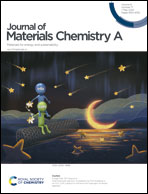Engineering yolk–shell P-doped NiS2/C spheres via a MOF-template for high-performance sodium-ion batteries†
Abstract
Transition metal sulfides generally demonstrate unsatisfactory capacity and a limited rate capability that still restrict their application for sodium-ion batteries. Herein, yolk–shell P-doped NiS2/C spheres were synthesized via a Ni-MOF template with phytic acid acting as a P source to significantly enhance the sulfide's sodium storage property. The yolk–shell P-doped NiS2/C spheres exhibited an ultrahigh initial discharge and charge capacities of 3546.7 and 2622.9 mA h g−1 with 72.9% coulombic efficiency, and maintained a relatively high reversible capacity of 1113.5 mA h g−1 at 0.1 A g−1 after 20 cycles. Electrochemical measurements further revealed that the yolk–shell P-doped NiS2/C spheres could also deliver a good rate capability and stable long-term cycling performance with 766.8 mA h g−1 reversible capacity at 0.5 A g−1 after 400 cycles. The satisfactory electrochemical results could be ascribed to the confinement and synergistic effect from the robust yolk–shell framework and heteroatom P doping. Therefore, it was demonstrated that morphology tuning and heteroatom P doping can serve as effective strategies to significantly improve the electrochemical properties of transition metal sulfides for sodium-ion batteries.



 Please wait while we load your content...
Please wait while we load your content...